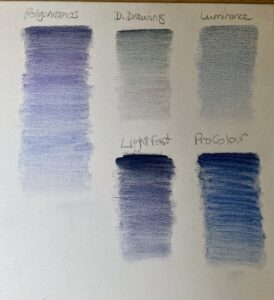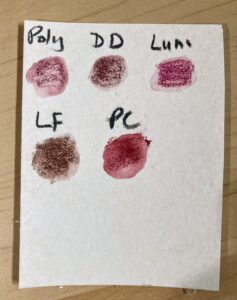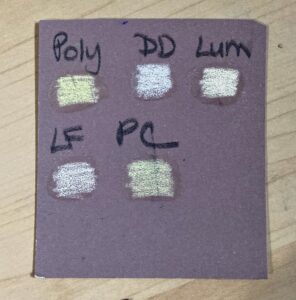Spoiler alert: Yes, you can do this but only on certain surfaces.
It is possible to blend colored pencils with water. I’m not talking about pencils designed to be activated with water: watercolor pencils, Graphitint, Inktense, and the like. I mean regular old colored pencils.
I saw an artist mention this in a YouTube video. I was looking for videos that showed colored pencils on canvas. One artist mentioned that he blended his Polychromos with water so I thought I would try it out.
It worked!!
I felt like I discovered fire this afternoon, so I wondered if my other pencils would do this and if they would do this on other surfaces. The pencils I have demonstrated are Polychromos (Poly), Lightfast (LF), Derwent Drawing (DD), ProColour (PC), and Luminance (Lum).
Canvas
 They all blended out on the canvas. I needed more water for the Polychromos than I did for the others, but that might be because they were the first pencils I tried and I was being conservative. I chose to make a blue gradient because I do a lot of skies and water in my wildlife work. Now some were more vibrant than others. The Polychromos, Lightfast, and ProColour were definitely more vibrant than the Derwent Drawing and and Luminance. Of all the pencils I tried, the ProColour seemed to retain the most vibrance.
They all blended out on the canvas. I needed more water for the Polychromos than I did for the others, but that might be because they were the first pencils I tried and I was being conservative. I chose to make a blue gradient because I do a lot of skies and water in my wildlife work. Now some were more vibrant than others. The Polychromos, Lightfast, and ProColour were definitely more vibrant than the Derwent Drawing and and Luminance. Of all the pencils I tried, the ProColour seemed to retain the most vibrance.
I should also mention that this is just the Artist Loft canvas from Michaels. I grabbed some cheap canvasses when they were on sale to use as experiments because I don’t have any experience with colored pencils on canvas. Having conducted this experiment, I think I might try my luck with canvas boards because I was afraid of putting the lead right through the fabric.
Uart
The next surface I used was Uart 400 grit. I didn’t try Fisher or Luxe Archival but I am betting that the result will be the same as they are also sanded papers. Also, I buy the other papers as boards so I can’t cut little squares to sample things. The pencils all blended on the sanded paper, but they didn’t all blend well. There was unactivated pigment in all of them, but the best was ProColour. The rest all contained larger amounts of unactivated pigment. The ProColour was also the most vibrant on this surface as well, once it was activated with water.
Archival but I am betting that the result will be the same as they are also sanded papers. Also, I buy the other papers as boards so I can’t cut little squares to sample things. The pencils all blended on the sanded paper, but they didn’t all blend well. There was unactivated pigment in all of them, but the best was ProColour. The rest all contained larger amounts of unactivated pigment. The ProColour was also the most vibrant on this surface as well, once it was activated with water.
Pastelmat
 The other surface that I tried was Pastelmat. I enjoy using this surface as well. It is one of my favorite pastel surfaces and I am starting to use it with colored pencils. The pencils didn’t blend out at all on the Pastelmat. The surface got wet but no amount of scrubbing with a brush would dissolve the pencils in water.
The other surface that I tried was Pastelmat. I enjoy using this surface as well. It is one of my favorite pastel surfaces and I am starting to use it with colored pencils. The pencils didn’t blend out at all on the Pastelmat. The surface got wet but no amount of scrubbing with a brush would dissolve the pencils in water.
My super-scientific conclusions
Water makes a dandy fine solvent for regular colored pencils on canvas. Demonstrating that irony is not dead, water as a solvent worked best with my oil-based colored pencils and ProColor, which is billed as an “oil-wax hybrid”. I was not surprised that ProColor worked well in this experiment because they perform similarly to oil-based pencils with Brush & Pencil Powder Blender.
I assume that the pencil blends out with water because the tooth of the canvas breaks up the pigment and renders the particle small enough to dissolve in something other than OMS, alcohol, or turpenoids. I could be wrong but the effect seems to be more mechanical than chemical. I was surprised that they didn’t blend out as well on the sanded paper. I hoped that they would blend out on Pastelmat but I wasn’t surprised that they didn’t because this isn’t a sanded surface. Is it cork or cellulose? I don’t know. I just know it isn’t grit that breaks down the particle in the same way Uart or Fisher 400 would.
I am interested in purchasing some watercolor grounds to apply to the canvas to see if the same thing happens.
